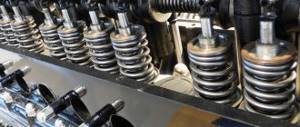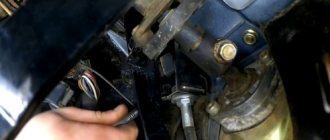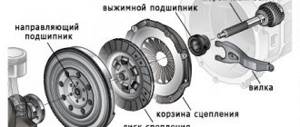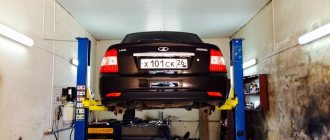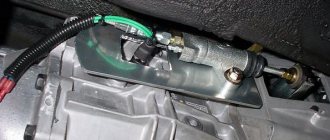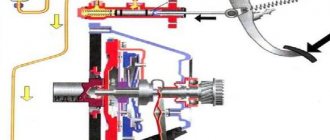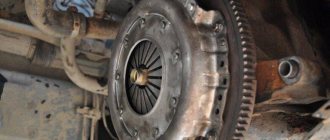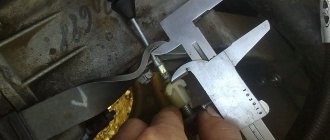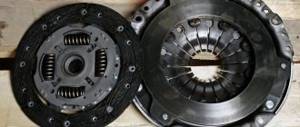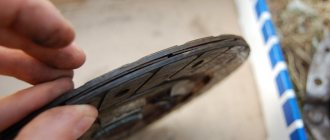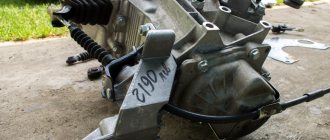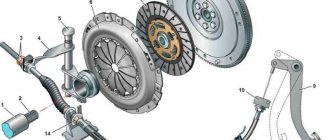Even the most complex and expensive double-disc clutch cannot do without a drive. The more devices and the more complex their design, the more susceptible the mechanism is to failure. The clutch is also no exception, and if there is practically nothing to break in its mechanism, then many weak points can be found in the drive. In each car they are expressed in their own way, but the most common breakdowns - the clutch pedal has failed, insufficient release of the discs are typical for most drive designs.
Clutch pedal failure is, unfortunately, a common failure
To understand the causes and eliminate the malfunction, it is enough to briefly familiarize yourself with the basic designs of clutch drives, and experience itself will tell you a way out of the situation. There are only a few schematic diagrams of drives, so studying their design should not cause any difficulties.
Mechanical drive
The simplest clutch is a single-plate dry clutch. It is used on all domestic VAZ, UAZ, GAZ cars, as well as on imported passenger cars Ford Focus 2, Renault Logan, Chevrolet Lacetti and many others. Clutch operation is based on the application of friction forces. The operating principle of any single-plate clutch is quite simple. The drive disk is rigidly attached to the flywheel, while the driven disk is mounted on the splined shaft of the gearbox and is constantly pressed against the driver by springs. As a result, rotation from the motor is transmitted to the transmission. The clutch operates smoothly due to the precise dosage of force applied to the pedal, and here the type of drive is very important.
Video tutorial on repairing a failed clutch
The main elements of this type of drive are:
- pedal;
- release bearing;
- rod or cable;
- shutdown plug;
- fork levers, boots, auxiliary rods.
The cost of a mechanical drive is low, so it is installed on inexpensive cars with front-wheel drive and on trucks of previous years - ZIL 130, GAZ 53, UAZ trucks. These machines were equipped with a cableless drive, where the load from the pedal was transferred to the fork using an adjustable rod. Adjusting the rod length ensured the desired free play of the pedal. This type of drive was installed in cases where the gearbox and clutch were structurally located at a short distance from the pedal block. The use of long rods led to inaccuracy when disengaging the clutch and difficulty in adjusting the free play.
All front-wheel drive cars, as in the photo, use a mechanical cable-type drive
The most commonly used clutch release cable is a cable drive. Almost all front-wheel drive cars - Daewoo Lanos, Tavria, VAZ 2108, 2109, Opel Astra, VAZ 2110 are equipped with a mechanical cable-type drive. The cable connects the pedal to the fork; it is assembled with a casing and sometimes a mechanism for adjusting the idle speed of the pedal. When the driver presses the pedal, force is transmitted through a cable and sometimes a linkage system to the fork, which moves the driven disc away from the driven disc, thereby disengaging the clutch and allowing the motor to be disconnected from the transmission when braking or shifting gears. The clutch drive system is necessarily equipped with a mechanism for adjusting the free play of the pedal, which can change as the friction linings of the driven disk wear out.
Hydraulic clutch drive
More complex and similar in design to the brake system drive. Its valves also use low-compression brake fluid. The main elements of the hydraulic drive repeat the design of the brake system:
- pedal;
- master cylinder;
- working cylinder;
- container for liquid;
- connecting line;
- fittings for bleeding the system.
Structurally, hydraulic cylinders consist of pistons and pushers, which are located in the housing. The piston in the working cylinder moves, displacing the working incompressible fluid, which transmits pressure through the line into the working cylinder. The working piston and pusher move the clutch release fork, thereby separating the engine and gearbox. This type of clutch is installed on VAZ 2101, 2105-2107, VAZ 2106, Moskvich 412, GAZ 2410 Volga, Mercedes and many others. Now that we know in general terms the structure of the two main clutch drives, we can talk about the characteristic features and breakdowns. There are several other types of drives - pneumatic, hydroelectric, but they are used mainly on robotic gearboxes, and pneumatic can be used on trucks and buses; such systems are not used on passenger cars.
Why did the clutch pedal fail?
Perhaps the most common malfunction on both types of drives, only the reasons can be completely different. Let's start with the mechanical clutch drive, as the most common one. The pedal may fall to the floor and the clutch does not react in any way to the pedal being pressed. This is the simplest type of failure, because the malfunction is obvious - the force from the pedal is simply not transmitted to the clutch fork.
The clutch pedal may fail due to a broken clutch cable.
In this case, the procedure for troubleshooting and troubleshooting is as follows:
- The rod that operates the clutch has become loose and the connection between the rod and the pedal is broken. In this case, it is enough to simply find the place where the linkage is attached to the pedal or auxiliary lever, tighten it and check the reliability of the movable connection of the linkage with the clutch pedal or fork.
- The clutch cable has broken or become disengaged either at the point where it is attached to the pedal or at the point where it is attached to the lever system or clutch release fork.
In both cases, there is nothing fatal and you can find a way out of each situation, the main thing is not to panic. It could be worse. A cable break always occurs unexpectedly and, according to the cable’s logic, it breaks without fail in the most difficult road conditions - on long climbs, on busy multi-lane roads. The psychological factor often prevents you from concentrating on the main thing. You don’t want to look like a teapot in front of your fellow drivers, so the most important thing is calm and the emergency lights turned on in time.
Open the hood and look at the condition of the clutch cable. It is quite possible that outside help will not be needed - the cable is intact and it can simply get out of gear. This happens on Renault Logan, Renault Sandero, Megan, sometimes on VAZ 2110 and the like. The cable is simply attached to the clutch fork, we exhale deeply and go on about our business.
In the case when the cable breaks in the casing - it frays, breaks at the points of attachment to the drive mechanism, there is also no need to panic. Experienced motorists carry a spare clutch cable with them just in case, but if you don’t have a cable at hand, you can get to the nearest car shop or service station without a clutch at all. In extreme cases, they know what to do. Some qualifications will be required, but experience comes with time. In a word, in order to get to our destination without a clutch at all, without asking anyone for a “tie,” all that is required of us is to clearly feel the engine speed. It’s better, of course, if there is a tachometer on the dashboard, but if it’s not there, it’s okay. With the engine off, engage first gear. We start the engine and move off automatically.
An experienced motorist always carries a spare clutch cable with him.
It will look funny, but we are not showing a driving master class, but getting to our destination. It is advisable to hold out in first or second gear. In the absence of intersections, this may work, but at traffic lights and in traffic jams you will have to turn off the engine and start again. Feeling the speed and synchronizers on the gearbox gears, you can shift even without crunching or jerking. It won't be possible to start moving without jerking.
How to drive a car without a clutch
As you can see from the list above, most clutch problems cannot be corrected in road conditions. Accordingly, if the clutch pedal has sunk to the floor, you will need to take the car to a service center. This can be done using a tow truck, which is quite expensive, in tow, which is not always possible, or by carefully getting to the service center yourself in a car without a working clutch pedal.
Important: This driving method should only be used if there is really no other way to deliver the car to a service center. Such driving is dangerous not only from the point of view of accidents, but also from the point of view of possible damage to gearbox elements.
In order for the car to move without changing gears when the clutch is not working, you need to proceed as follows:
First of all, stop the car engine;- Next, shift the gear lever to the first gear position;
- The next step is to start the engine. To prevent the car from stalling immediately, lightly press the gas pedal. It may not be possible to start the engine the first time. Do not forget that after each unsuccessful engine start, you need to give the starter a couple of minutes to rest so that it does not break down;
- When the car starts moving, you need to do everything possible to avoid all kinds of stops - at traffic lights, in front of pedestrian crossings, on turns, and so on. Choose a route to the service center that will go along the main roads so that you do not have to let cars through. Prepare in advance for each traffic light, slowing down or speeding up if necessary. Remember not to shift into second gear, otherwise it may damage the gearbox.
Please note: Experienced drivers may try to start the engine straight from second gear. In this case, it will be possible to travel by car faster, but it will be more difficult to do.
It is worth paying attention to several details of such driving:
If the car's clutch pedal fails when it is moving uphill, the likelihood that it will be possible to start the engine from first gear is extremely low. In this case, only a tow truck or tug will help you get to the service station;- When driving without a clutch, do not forget about the rules of the road;
- Be sure to turn on the hazard lights on your car so that surrounding drivers have an idea that your car is faulty. In addition, since the car will move in first gear, you should not drive it on highways. Remember that you cannot drive on the highway in a car whose speed, for one reason or another, does not rise above 40 kilometers per hour;
- Try to stay in the far right lane when driving.
Let us note once again that you should resort to driving a car without a clutch only as a last resort. If it is possible to use a tow truck or tug, do it.
( 392 votes, average: 4.52 out of 5)
Additional automatic transmission cooling radiator
Engine oil level rises
Related Posts
Reasons why the pedal goes to the floor with a hydraulic drive
If the clutch drive is hydraulic, as on classic VAZ, Ford Focus 2, Volkswagen Passat, Skoda Octavia, Peugeot 206, Fiat Ducato, Scudo from 2000, most likely the system is simply airy. In this case, it requires bleeding, like any brake circuit. This is done according to the same principle as bleeding the simplest brake system. The purpose of bleeding is to completely remove air from the system. The fluid used is exactly the same as in the brake system. On the Audi 80, for example, the main hydraulic cylinder is directly connected to the pedal, and the working cylinder is installed in the crankcase.
Bleeding the system will take two minutes; the main thing is not to forget to add fluid to the tank to the maximum level. In hydraulic clutch drives, a leak will indicate a malfunction. So, on the Mazda 6, the drive hose is located under the battery platform, so some flexibility may be required to detect a leak. But there are no unsolvable problems. If you approach any problem wisely, it will be solved in no time, and we will gain valuable experience.
The clutch pedal has fallen and does not return, what is the problem?
Why does the clutch pedal squeak?
When the clutch pedal fails and does not return, this means only one thing - the end of the clutch has come. You need to somehow get to a service station or change the clutch parts yourself. The difference may be that only the release lever could break, but the disc and basket will still serve for some time. And there are cases when both the disc and the basket are so worn out that it is better to simply change the entire clutch assembly.
If the clutch fails, then the main thing is not to panic, this is an everyday matter and sooner or later it was bound to happen. But this situation, when the clutch pedal fails, does not always mean that the clutch needs to be changed. Sometimes there are cases that the brake fluid has simply leaked out and you need to top it up and see where it is leaking and fix the gap. But there are other reasons why the clutch pedal does not return to its original position.
